
Welcome back to another Sunny Mary Meadow podcast/blog post. I am your host, Liz Fiedler. Our last episode/post with Megan and Mallory from Blooming Creek Flower Farm (“The Twins”) got a little lengthy, so we ended up cutting it in half at a good stopping point, and we’re starting up again talking about dahlias.
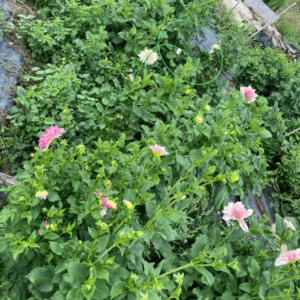
As a reminder, because they sound so similar on the podcast, and it’s hard to tell them apart for writing the blog, they will mostly be referred to as “The Twins.” They said to treat them as one, so that’s what we’re going to continue doing.
Liz: Honestly, when the frost comes, it’s kind of welcomed. You go through and hack them down, and then you can kind of just leave them there until the ground is frozen solid. Even if it thaws and refreezes or snows, as long as the ground is frozen solid, they’re fine. The first few years I had the flower farm, I did the dahlias right away, but I have realized now that that’s not the priority – get the other stuff done. They can sit on the ground until you’re ready for them … within reason. Don’t wait until like December, but they can sit in the ground all of October. It’s fine.
And then I take my potato fork … I think you guys use one, too … rather than a shovel. That way, you can loosen all the dirt off of it at the same time. Then you guys are going to be kind of shocked; well, actually, you know how lucky I’ve gotten with storing my dahlias the last few years. I don’t know, I’ve been like, “Let’s simplify it,” and I’ve gotten really lucky. I mean, last year, I didn’t even cover them. They were in clumps of dirt, and I just stuck them in bags and then in a tote. I didn’t even put a lid on the tote, and they just stayed like that all winter long until I was ready to divide them this spring. And they were great. That’s how our grandmas used to do it in the basement.

The thing is, though, that I have a shop where I can keep heated at 40 degrees, and I can put 20 huge totes in there if I need to. It’s so big – in fact, we lived there last year for seven months when we were building our house. It’s like 70 years old, but it’s insulated well, and there’s a heater in there. So, if storage is not a problem, that’s what I would recommend, and then divide them in the spring when you’re ready to plant. It’s a lot easier to see the eyes. Plus, in the shop, we don’t have to go up and down stairs. Brent … “Flower Farmer Fiancé” … is all about efficiencies. He’s very concerned that I’m going to be a cripple when I’m 60 because I’m always bent over gardening. He’s like, “I don’t like this. You have a doctorate degree, and you’re physically using your body for flower farming.” I’m like, “Well, whatever, it’s fine.” So, he’s about efficiencies and ergonomics to make it easier on my body. He already has pallets set aside so we can move things with the skid steer inside the shop. We’ll have pallets of totes.
However, if storage is an issue for you or you have to go up and down stairs, for example, I wouldn’t have 300 dahlia plants in totes with the whole root ball in the dirt. That’s when you’d want to divide them in the fall. Because one saran-wrapped ball takes up way less space. But I have the room and waiting to divide them until spring works for me. What do you guys do?
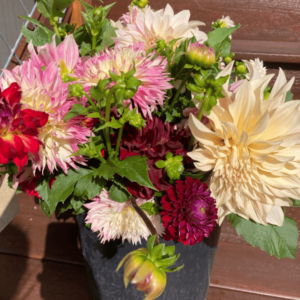
The Twins: We have a heated garage, but we don’t have as much space for that as you do. So we let the frost come, cut the plant off at the bottom, let it sit in the dirt for at least a good week or two … depending on what the weather does, sometimes it’s two to three weeks, dig them up with a potato fork, let them sit out on the trailer for a few days to air dry, shake off the dirt, and then we divide them right away. We try to get that done within a week’s time, but you should probably try to get that done even a little sooner if you are going to store them. We’ve found that if we haven’t, we lose some to rot too soon. So again, we divide them right away, and they’re labeled because we are labeling them in the summertime, so we know what variety is what. Once we’ve divided them, we put them in saran wrap, and then stick them in a tote, and put them in Megan’s basement on the farm. We have part of the basement that’s not heated (it’s an old part of the basement), so we can kind of control the humidity with a dehumidifier. It stays about 40-50 degrees down there, so it’s perfect for the tubers.
Liz: Yeah, I guess I actually did it two ways last year. If you’re gonna keep them in clumps without dividing them, leave the dirt on them like I do. But again, that’s heavy and dirty, and it’s not ideal for everyone. Again, it’s how our grandmas used to do it, and it works best, but there are a lot of factors that go into that. But if you’re going to wash them in the fall, then you really should divide them right away. I somehow lucked out – I ran out of time last year because we were moving into our house, so they were cleaned, and I literally just wrapped the entire cleaned root ball (there was no dirt on it) with saran wrap and then threw them in totes. I figured they would die, but at the time, I didn’t even care. I didn’t even label them – I had no idea what they were. And this spring, they had eyes poking out of them! I think the saran wrap probably helped.
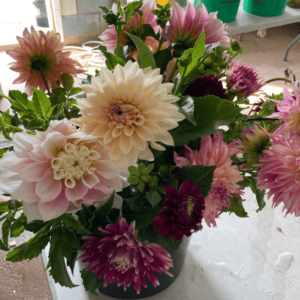
That being said, I’m not going to gamble on that again. I’ll either leave them in the dirt, divide them, wrap them, and then store them. But if I do divide them, I wrap them individually in saran wrap, and that’s always worked well for me. Wrapping the whole root ball in saran wrap was a gamble because if it rots, you lose 10 tubers, whereas if you divide them, you may lose one or two, but not all of them.
How do you guys store them?
The Twins: Oh, we left this part out … the most important thing after we take them off the trailer and divide them up is washing them and letting them drive for a couple of days. It’s a mess to wash them.
Liz: It sucks because you have to be careful where you do it. I’m so dumb sometimes … one year, I did it by my milk house and got mud everywhere on my concrete. So, then I sprayed it with a hose. Now, my Class 5 gravel/crushed rock has all this dirt in it, so I have weeds all over. I was complaining that there were so many weeds by the concrete, and Brent was like, “I wonder why … you put dirt in it all the time when you’re washing things!” I was like, “Ohhhh … duh.”
It’s hard to find a good place to wash them. You really should do it on concrete or something. You don’t want to do it on grass because then all of a sudden you have all of these dirt clumps all over the grass, and you don’t want to do it in the garden because then that’s messy. There’s just not a great place to do it.
The Twins: Last year, we lucked out, and it was a 70-ish-degree day.
Liz: Yeah, and you try to let them dry out, so the dirt clumps fall off a little bit better. I’m doing that with my ranunculus right now. I’m trying to save all of those corms … we’ll see. I’ll keep you posted on how that goes. But it’s a similar thing. I water them really well before I pull them, so they come out more easily, but I’ve still had to use my hori-hori knife. Then I let them kind of dry out, so when I shake them, all the excess dirt comes off. I do that for my ranunculus and dahlias when I divide them in the fall. I still wash them in the spring, though, too.
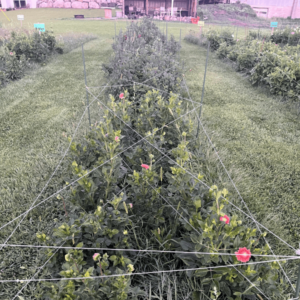
Honestly, by fall, I’m so burnt out. I’m really hoping we can store them this year and then start dividing dahlias in February. Especially now that flower farming is my full-time job. I work one day per week as a nurse practitioner, for those of you who haven’t read the blog before this. So, I work a 12-hour day once a week doing that, and then I flower farm full-time. I have an employee and over 100 subscription holders every week all summer long, I have multiple events every week all summer long. I’m slinging about 200 bouquets a week, so it’s very busy. But I do need stuff to do in the off-season. So, I’m trying to prioritize it all. If there are tasks that I can do in the winter, sweet, and then do the more “valuable” things when they need to be done. Like in October, I need to be planting tulips.
Did I tell you guys about how many tulip bulbs I ordered for next year?
The Twins: No …
Liz: Just take a guess how many I ordered. This year, I had about 11,000.
The Twins: I’m going to say you doubled it, probably.
Liz: Twenty-six thousand (laughing)
The Twins: Oh wow!

Liz: We’ll talk about that in our group text, but I’m going to have a tulip bulb sale. My theory is that it can’t take that much longer to plant that many compared to the amount I did this year – it’s not like it doubles the time. You’re doing it anyway. So that’s why I don’t like to divide in the fall either … because I have a lot of those types of things going on.
Does one of you want to talk about the dahlia sales on Instagram? For some of those rare varieties, it is cut-throat … you have like 10 seconds to add to cart and check out.
The Twins: Yeah, dahlia sales can be pretty crazy. They usually ramp up in like December/January, and as soon as there’s an announcement that a specific store is opening up at 10:30 on a Sunday morning, you better be ready with your cart full by 10:31 and be checked out.
Liz: And have a list ahead of time of what you’re going to do and know what you want. They’re insane.
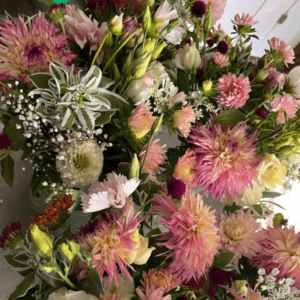
The Twins: The most coveted varieties will be gone. There are times we’ve both been on sale at the same time on different devices/computers, and we still miss out. It can definitely be pretty cut-throat.
Liz: So, you have your 57 varieties, and that’s a testament to finding a balance between what your customers want and what you want. Do your customers appreciate the variety of dahlias? Or do they not really even notice?
The Twins: I think there’s probably a little bit of both. The subscription holders definitely look forward to when those start getting included in their bouquets. And then, of course, it makes the you-pick events more fun when they can come to see all of the different varieties in the field and pick which ones are their favorites. I’d also say that we have so many different varieties because we have our tuber sale and want variety. So not just sell six varieties but offer at least 20 varieties if we can (if they store well in the winter). I mean, we could have double and 100 varieties if we wanted to, but we’ve pared back, and this is what works for us for now.
Liz: Have you ever gotten rid of a variety? Or do you always plant the same ones?
The Twins: Oh yeah, we’ve cut a lot of them. Cut a lot back.

Liz: So, which varieties don’t you grow anymore? Do you remember?
The Twins: Some of the bigger dinner plates. We had one that was called La Luna, and it was a huge, like 8–9-inch, yellow bloom.
Liz: Yeah, I used to grow that one, too. I don’t do it anymore, either.
The Twins: They have such a short vase life.
Liz: Yeah, it was like a day.
The Twins: And it didn’t produce very many tubers.
Liz: Yeah, one tuber would only turn into like three.
The Twins: Yeah, so that one, and then there are a couple of white ones last year that we got rid of, but I don’t remember their names. We didn’t do them this year.
Liz: Yeah, I can’t remember what they’re called, but I have a couple of white ball dahlias. I actually have a lot of those this year. But again, I lucked out. I didn’t know that every bride in Minnesota wants only white flowers. When did that start?
The Twins: Yeah, exactly!
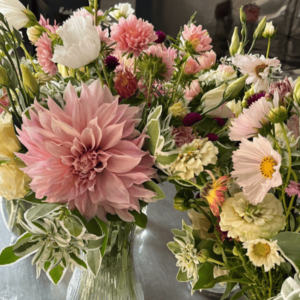
Liz: That’s annoying! I’m sorry; I know that’s not very nice of me to say.
The Twins: It’s a trend.
Liz: You’re boring! There’s so much color out there. I’m probably offending someone, and it’s not very nice, but I don’t get it. I don’t get it. I shouldn’t be going off on a rant, and I’m not trying to be judgy … well, maybe a little bit judgy. But it’s not going to look how you think it’s going to look. My dad is going to show up in a plaid shirt, and it’s not going to look as nice as you think it’s going to.
The Twins: Exactly.
Liz: I don’t know. Or, I had one bride whose wedding I was doing, and I talked her out of this, but she envisioned her head table being all colored flowers and the head table being white. I shouldn’t say I talked her out of it, but when we were going over the options and talking about it, she said she thought it would really stand out. I told her she’s already going to stand out. And if anything, I’d do it the opposite way because she can control what her wedding party is wearing. I explained that I didn’t think it was going to look the way she thought it was going to look. Because her guests aren’t going to be wearing white or black, I said if it were me, I would do all white or all colors because I just don’t think it’s going to look the way she wants. And she’s buying a lot of flowers … like 12 buckets of flowers for centerpieces, etc.
So anyway, I have the white ball dahlias and just kind of lucked out. I’m using more and more white flowers, but I don’t know, I’m just not really drawn to a lot of white.
The Twins: We’re not either.

Liz: Even like with a white snapdragon, it just sticks out.
The Twins: Yeah, it takes a special color palette to use a lot of white.
Liz: For example, I have a bouquet sitting here that I made for Abbey, my podcast producer, that I made for her to take home just as a thank you, and there’s one white zinnia. It’s an Oklahoma Salmon, so it’s so pretty. I mean, I don’t even plant that many Benary’s Giants anymore because I feel like the petals just get crushed so easily, so I do a lot of the Oklahoma Salmon – many different colors of those and then the Queen Lime. So anyway, there’s one white Oklahoma Salmon zinnia in there, just one, and it’s what you look at immediately because it just sticks out. I don’t know. I just do a lot of pinks and purples.
The Twins: Yeah, we’re more colorful that way, too. It’s a little more versatile.
Liz: Obviously, there are so many different colors of dahlias, and I’m excited to continue growing them.
The Twins: That’s the best part about growing them. There are so many shapes, sizes, and colors that you can really have a lot of variety.
Liz: I need to give you guys a couple of whole plants because I have far too many of these. Last year, one of my customers gifted me an entire plant that was HUGE. I divided it up into about 30 tubers – it’s insane. Okay, maybe not 30. I think it was 27 tubers from one plant … with viable eyes. And it’s the variety that was supposedly in Abraham Lincoln’s garden.
The Twins: Oh wow!
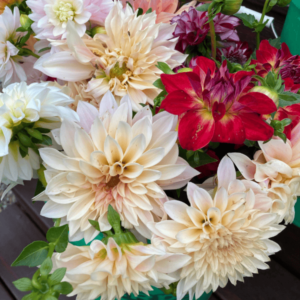
Liz: Her husband’s grandma gave it to her or something, and she said they just divide like crazy. I just want to give you one of these, and she kept the rest. Now I have 50 of them! I divided the plants and then threw away a lot of them because last fall was so busy, and I already had 27. They’re the first to bloom – they’re already budding. They’re a deep red color, and I think reds are coming back in. I need to give you guys one of those. They’re really pretty. It’s a ball dahlia.
The Twins: That would be awesome!
Liz: I have no idea what it’s called. I call it “Abe.” I wrote “Abe” on the label – that’s one I did label last year. People have been like, “I want some of the Abe,” but I would feel bad selling them because they were given to me. And I’m like, “Is this some heirloom dahlia that I’m not supposed to pass on?” I don’t want to piss off her grandma. I don’t know.
Do you guys ever do a swap with other flower farmers, or siblings, or anything like that?
The Twins: We haven’t really yet, no. Other than with you amongst our flower farmer friends.
Liz: I’m going to do an episode soon with my friend Stacy Armoch. She saves a lot of her seeds, so she does a seed swap out in Michigan. That’s part of my dream, like within our Mastermind group … doing a dahlia swap. When we get together this winter, I’d like to have us all bring enough for everyone to take home this many of a different dahlia or something. I don’t know, I think it would be fun.
The Twins: Yeah, I like it!
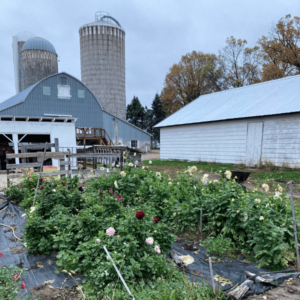
Liz: It would be fun to check in with each other … “How’s it doing?” “Terrible, why did you give me that one?” (laughter) “It’s your fault. I have someone else to blame.”
Last year, I basically planted my dahlias in blacktop soil; it wasn’t compost. It was terrible. That’s why I had to buy so many from you guys for this year. I knocked down a building, leveled it off, and brought black dirt in … I mean, we tilled in some compost, but obviously not nearly good enough. This year, they’re in a new location, down in the meadow, which is really nice, black dirt with a lot of organic matter down there.
The Twins: Do you want to touch on what happens after a frost? Like how after a frost, they turn black and die back, and you can’t distinguish what’s what. That’s why it’s so important to label while they’re alive and blooming.
Liz: Yeah, when the frost comes, they turn into black mush. It’s so pretty for like a day … or maybe an hour … while it has frost on it. But then they are black mush. It’s terrible.
The Twins: It’s the nail in the coffin for the season.

Liz: Honestly, every year so far, I’ve been so burnt out that by the time it happens, I’m ready. I’ve changed so much this year that I hope I feel differently. I’ve set pretty good hours, and I’m not doing flower stuff on the weekends, really. I mean, we’re still doing yard projects, but I’m trying not to. This has to be sustainable. But usually, when that frost hits, I’ve been ready. I’m like, “Good. I’m done.”
The Twins: We were sad about it last year. It came too soon.
Liz: You’re right that first frost did come way too soon last year. That’s another thing – last year, I actually would have been done then, too, but I put a sprinkler on mine. That’s something you guys can try if you want; I don’t know how it will work when the area is so big. But if you do an overhead sprinkler, when it’s going to be a light frost, it can save them. I thought it was worth a try anyway … my dahlias were so late last year, and they still didn’t bloom a whole lot … so I wanted to try to prolong them. I plan on using a lot of overhead sprinklers this year if I have to. It warms up the air temperature a few degrees so it doesn’t freeze. The water out of the hydrant is 50 degrees, so it warms up the air. Or you can do frost cloth.
The Twins: We did buy frost cloth just in case we need to save a few rows for a couple more weeks of subscriptions, depending on when the frost hits. But usually, by that time, we’re ready to be done with it, too.
Liz: It’s the circle of life with the plants.
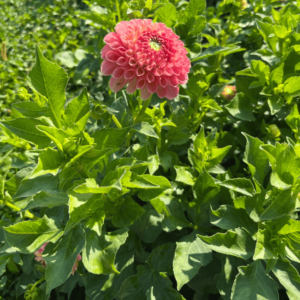
The Twins: Plus, you know all of the work that’s ahead of you yet, too.
Liz: Yeah, it’s a different kind of work. It’s fun.
The Twins: You had said something earlier about how people are so intimidated by dahlias in our zone (4B), and the reason is that they are such a tender annual, and they don’t have a good way to store them or they don’t know how to divide it.
Liz: If you only have one of two of them, the closet in the guest bedroom that’s usually kept closed might work.
The Twins: Or in a garage.
Liz: Honestly, I’d say too warm is better than too cold. If it’s too cold, they die. If it’s too warm, they just don’t go dormant and start growing a little sooner. I’ve had times where I’ve taken one out of saran wrap, and there’s a nine-inch stem in there. You just break or cut it off at the base. You’re not going to get a plant out of that.
The Twins: Yeah, I’d say it’s probably the task of dividing them, finding the eyes, and storing them. That’s the intimidating part. But once you’ve done it a season or two and have a system that works, it becomes a piece of cake.
Liz: Exactly. That’s the point I’m at now. I used to think it was insane … like, “How do people do 5,000 dahlias?” but now it doesn’t seem so crazy.
We talk about how dahlias start blooming in early August, but really, that’s usually just one bloom per plant. That’s not enough to use consistently. How many weeks do you think here in Zone 4B, we have dahlias blooming enough to actually pick them? Like to count on them?
The Twins: I would say about 6 weeks. It’s not very long, considering how much work goes into them.

Liz: If we were people where it was August 1st through October 1st, and we got a solid 2 months out of them, it would feel more worth it. But here it’s 6 weeks in a good year. Sometimes, we only get about 4 weeks, depending on when the first frost is.
The Twins: Yeah, last year was closer to 4 weeks. Or maybe 5. The year before that, though, we didn’t have a frost until mid-October, so that was late, and we had lots of extra weeks.
Liz: Yeah, we’ll see. I’ll give it a bit longer and try to figure out what I want to plant. I need to get more blooms out of there, so I’m definitely going to look into that fertilizer you guys recommended (Dr. Earth Bud & Bloom Booster – it’s in a pink bag).
The Twins: Yeah, it’s a good one. It’s all we really use, and it’s worked well so far.
Liz: Abbey, any questions?
Abbey: After an hour’s worth of dahlia-talk, I feel like I’m an expert at this point.
Liz: Well, of course you are. Of course, you are.

Abbey: Don’t do the dinner plate ones; do the smaller ones. I know how to tie them up now. Don’t use bone meal because my dog will go dig it up.
Liz: Yeah, exactly. Exactly.
The Twins: Does the growth cycle make sense, Abbey? You know how it’s a tuber, then it becomes a plant, you have to divide it, and that not all tubers are going to have an eye, so not the whole plant is going to be viable for the next year, so you have to divide them up, etc.
Abbey: Yeah, I followed along pretty well, and I started with zero knowledge of dahlias.
Liz and The Twins: Perfect!!
Abbey: It helped that you guys compared it to a potato right away.
The Twins: Yeah. It really is like a potato, yes. It multiplies the same as a potato.
Liz: Why don’t you guys tell us where we can find you on social media? Facebook, Instagram, your website? Tell us all the things.
The Twins: Sure, we do have a website. We are on Instagram and Facebook. Our logo is purple with our name on it.
Liz: Well, thank you both so much for joining me. And Abbey, thank you as always.
The Twins: Thanks so much for having us! It was fun!

Additional Note from Liz: Hey, everyone! I want to talk quickly about my course that I’m launching this fall, Peddling Perishable Products. Essentially, if you like the episodes where I tell you how to grow the flowers, I really think you’re gonna like the episodes where I tell you how to sell the flowers. Ultimately, I tried creating some podcast episodes talking about how I do things, and it just felt incomplete, and I really want to make a difference. I want to make it easier on you, and I don’t want you to find out how to do things the hard way.
If you want more information on how to sell your flowers and turn them into a comprehensive business, go HERE and sign up for a Calendly call. I promise it’s not intimidating. It’s 15 minutes where I’m going to tell you the stats on my sales, and I’m going to ultimately give you information on the course. If, at the end of the phone call, the answer is no or not yet, I promise no hard feelings. I just really, really want to help you turn your flower hobby into a successful business if that’s what you want to do. Again, no hard feelings, just sign up on the Calendly link. Thanks!
Thanks for reading the Sunny Mary Meadow blog. If you like what you’re reading, please subscribe to the podcast and rate us. You can also find us on Instagram, Pinterest, and Facebook.
You can subscribe to our email newsletter below. We love to hear any podcast-related feedback at our email podcast@sunnymarymeadow.com, and all other inquiries can be sent to liz@sunnymarymeadow.com.